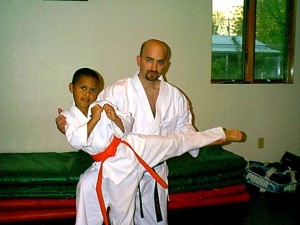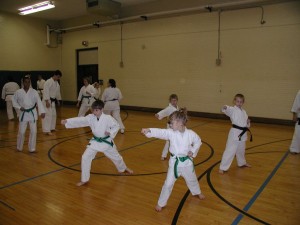 The best karate dojo is not always the most expensive. Many of the best schools charge very low membership fees so they can make the training available to all who may be interested. These karate schools are more interested in teaching karate than in making money, although money is needed to maintain the dojo. All students are expected to pay their dues on time and in this way share in the expense and responsibility of maintaining the dojo.
The best karate dojo is not always the most expensive. Many of the best schools charge very low membership fees so they can make the training available to all who may be interested. These karate schools are more interested in teaching karate than in making money, although money is needed to maintain the dojo. All students are expected to pay their dues on time and in this way share in the expense and responsibility of maintaining the dojo.
The dojo is a sacred hall of training, to show respect for the karate dojo all students should bow (rei) before entering and leaving the dojo. Street shoes are not to be worn in the training area. In the most outstanding dojo, the students are expected to do more than just show up for class and then leave. They must help keep the dojo clean by sweeping, dusting and cleaning the training area. Karate uniforms (gi) must be worn properly, kept clean and in a good state of repair. A good karate school teaches both pride and humility in ones self.
Dojo Etiquette
1. Respect will be shown to all karate-ka at all times. Students will refer to the head instructor as Sensei, both in the dojo and out. All black belts will be addressed as Mr., Mrs. or Miss followed by their last name. This form of address will be used inside and outside the dojo, the black belt may indicate not to do so outside the dojo.
2. Greet each black belt before class.
3. A bow of respect will be given whenever entering or leaving the training area.
4. Be ready and warmed up for class when it begins.
5. A bow of respect will be given before and after addressing an instructor or fellow student.
6. All students will show higher ranking students the respect their rank deserves.
7. Shoes are not to be worn in the workout area.
8. Misconduct and talking will not be tolerated in the dojo it shows disrespect to your Sensei. You are there to train, misconduct interrupts that training not only for you but for the others as well.
9. Your rank signifies more than just where you stand, it indicates your level of responsibility.
10. Never teach techniques or conduct demonstrations without the prior consent of your Sensei.
11. Students should not wear earrings or other jewelry.
12. When seated around the outside of the dojo it is considered disrespectful to allow the bottoms of your feet to point toward the center of the dojo. Please do not lean against the walls when seated.
13. If you have any questions, please talk to one of the black belts.
Please note that the dojo belongs to all the students; therefore, they are expected to share in the responsibility of maintaining the dojo.
Dojo Kun
1. Jinkaku kansei ni koto. (Work to perfect your character.)
2. Makoto no michi o mamoru koto. (Have fidelity in seeking a true way.)
3. Doryoku no seishin o yashinau koto. (Cultivate a spirit of endeavor and perseverance.)
4. Reigi o omonjiru koto. (Always act with good manners.)
5. Kekki no yu o imashimeru koto. (Refrain from violent and uncontrolled behavior.)
In these five precepts, we have the essence of a teaching that enables karate to be seen as something more than simply a method of random mayhem or a modern competitive sport. This is the morality, which is needed to balance the physical in training. It is the foundation of what in Buddhism is called “right action” (Samma-kammanta); ignoring the beliefs and ideas encapsulated in the dojo kun will in the long run have a negative effect both on the individual martial artist and on the evolution of karate as a whole. It is the worthwhile looking at the precepts individually.


